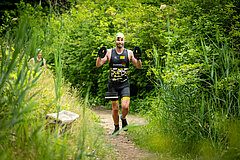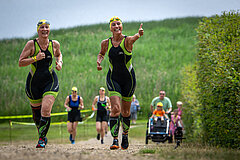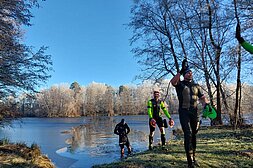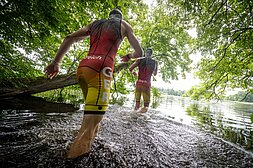SwimRun World Champion at SCC EVENTS Training Course
Lots of Answers to Women-Specific Questions in SwimRun
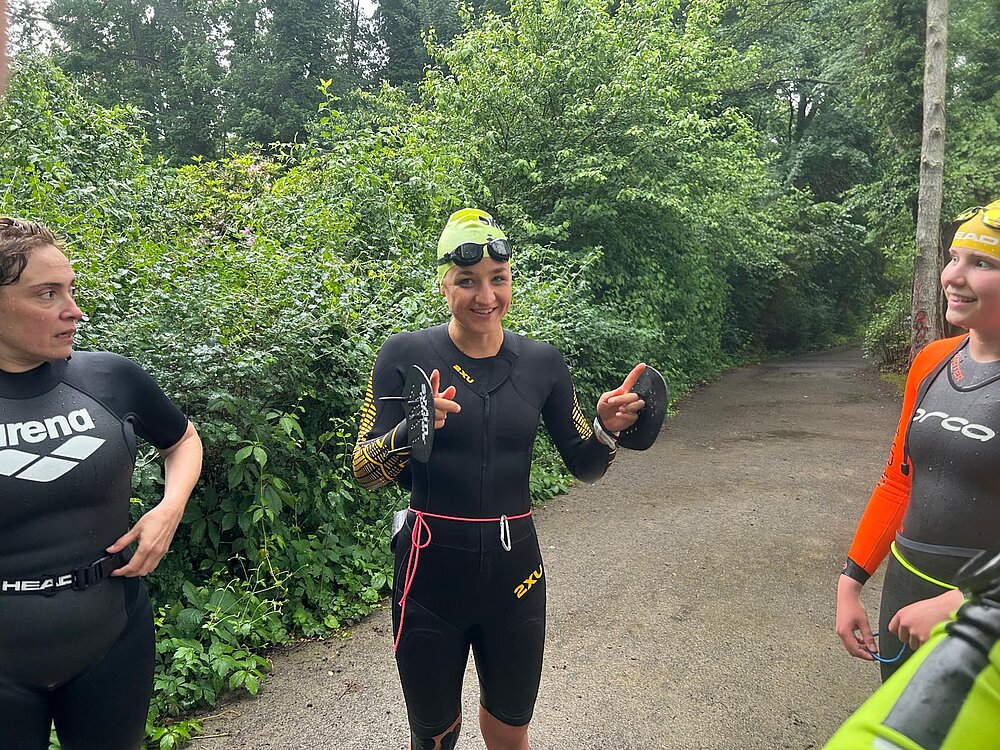
Celia Jentzsch (center) answered questions at the SwimRun training course by SCC EVENTS. © SCC EVENTS / Philip Lehmann
1. Question to Celia: Where does the sport SwimRun come from?
SwimRun has its roots in Sweden. It all started in 2002 with a bet between friends who challenged each other to travel from point A to point B across several islands — solely on foot and by swimming. This led to the first official race in 2006: ÖTILLÖ ("island to island") in the Stockholm archipelago. Today, it's considered the most legendary SwimRun race in the world and has inspired an entire sport that is now practiced internationally. In Germany, SwimRun Rheinsberg is one of the top-tier events.
2. Question to Celia: How do I find the right wetsuit for SwimRun?
A SwimRun wetsuit is very different from a traditional triathlon suit. It needs to be flexible enough for running, while still providing warmth during the swim segments. Typical features include front and back zippers, built-in pockets for nutrition or safety gear, and short or removable sleeves and legs depending on weather conditions. A good fit without chafing and enough freedom of movement while running is essential — ideally, you should test the suit before buying, e.g., through rental options or at SwimRun events.
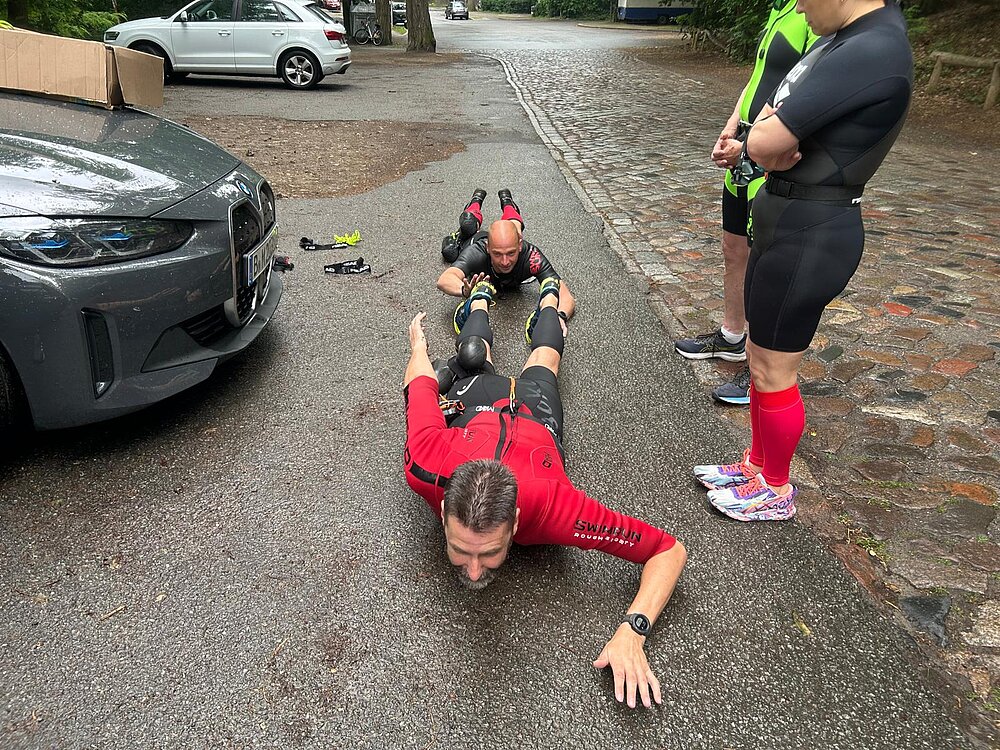
Dry exercises to get ready for 1.5 hours of SwimRun fun. © SCC EVENTS / Philip Lehmann
3. Question to Celia: What kind of shoes are suitable for SwimRun?
In SwimRun, you wear specific shoes that work well for both running and swimming. They stay on for the entire race and are characterized by low weight, good drainage, grippy soles for slippery terrain, and a secure fit.
4. Question to Celia: How do you find your rhythm in SwimRun?
For me, swimming is the moment when my system resets. I use that phase to lower my heart rate and find a steady breathing rhythm. I swim with power and focus, but not at top speed — it’s more about efficiency and consistency.
Running is different: heart rate rises, body temperature increases, and the effort intensifies — especially on technical or steep sections. Breathing still plays a key role, but it becomes more dynamic and terrain-dependent.
Pace is not the defining factor in SwimRun — it’s much more about constantly recalibrating your rhythm. Breath control, body awareness, and adaptability are key. Ultimately, it’s a constant balancing act — finding rhythm in the un-rhythmic.
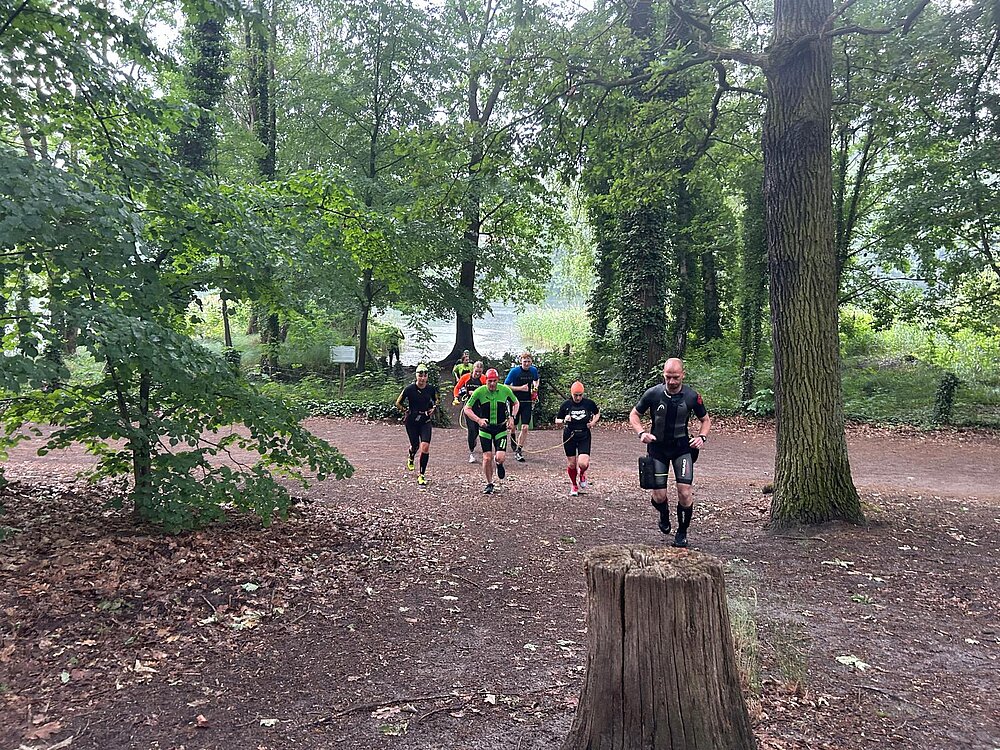
Trainer Michael in full gear leading the way, with the rest following, panting. © SCC EVENTS / Philip Lehmann
5. Question to Celia: How does swimming with paddles work in SwimRun — and how do you manage your strength?
Paddles are a core tool in SwimRun — but they’re also a real challenge. They come in different sizes, from small finger or hand paddles to larger ones made specifically for SwimRun. The rule of thumb: the larger the paddle surface, the greater the catch in the water — and theoretically, the faster the pace. But that only works with clean technique.
If you just start paddling away, you risk overuse — especially in the shoulders and elbows. That’s why it’s important to increase gradually and start with smaller paddles to learn the motion and prepare your body.
For women in particular, the upper body often isn't naturally as strong as men’s — which is why targeted strength training for shoulders, arms, and back is essential. Swimming with paddles requires power. If you're not prepared, it becomes purely a strength issue — and no technique will save you.
For me, it's clear: to swim effectively with paddles in SwimRun, you need both solid technique and deliberate upper body strength. And that's not a drawback — on the contrary: it’s a great opportunity to grow as an athlete and unlock new potential.
6. Question to Celia: How do you manage your menstrual cycle in training — and what helps with cravings during your period?
I think one of the most important steps is not to see your cycle as a burden, but as part of your strength. Especially in elite sports, you often "perform better" when the cycle disappears — because it makes you seem more consistent and predictable. But that’s not just risky for your health, it also takes away a core part of what makes us women. I have to remind myself: our cycle is not a disadvantage — it can be a compass, if we learn to listen to it.
As for cycle-based training — sure, in theory there are many recommendations: in the follicular phase (the two weeks after your period), the body tends to be more powerful — so intense intervals, strength training, and higher loads are more feasible. The luteal phase before your period is better suited to aerobic, lower-intensity sessions, depending on how you feel. But: this only works if you even have a regular cycle. And that’s not always the case in endurance sports. I’ve had — and still have — phases when my cycle is off balance, and I often struggle to interpret my body’s signals; I’m no expert, but I try to develop a better feel for it, step by step. The body offers the best guidance — but truly understanding it takes time, patience, and honesty with yourself. Still, sometimes a race falls right in a phase when you're not at your best. That’s part of it too. Then it’s about accepting it, adjusting, and giving everything you’ve got on that day.
Regarding cravings: I think it should be approached with ease. In the second half of the cycle, the body undeniably uses more energy — and you should give some of that back. For me, nutrition is about balance. Functional, yes — but also enjoyable. If I crave something sweet, I intentionally include it (as a pre-workout snack or post-workout treat). You don’t need to justify every piece of chocolate. In the end, it’s about building a connection with your body based not on control — but on trust.
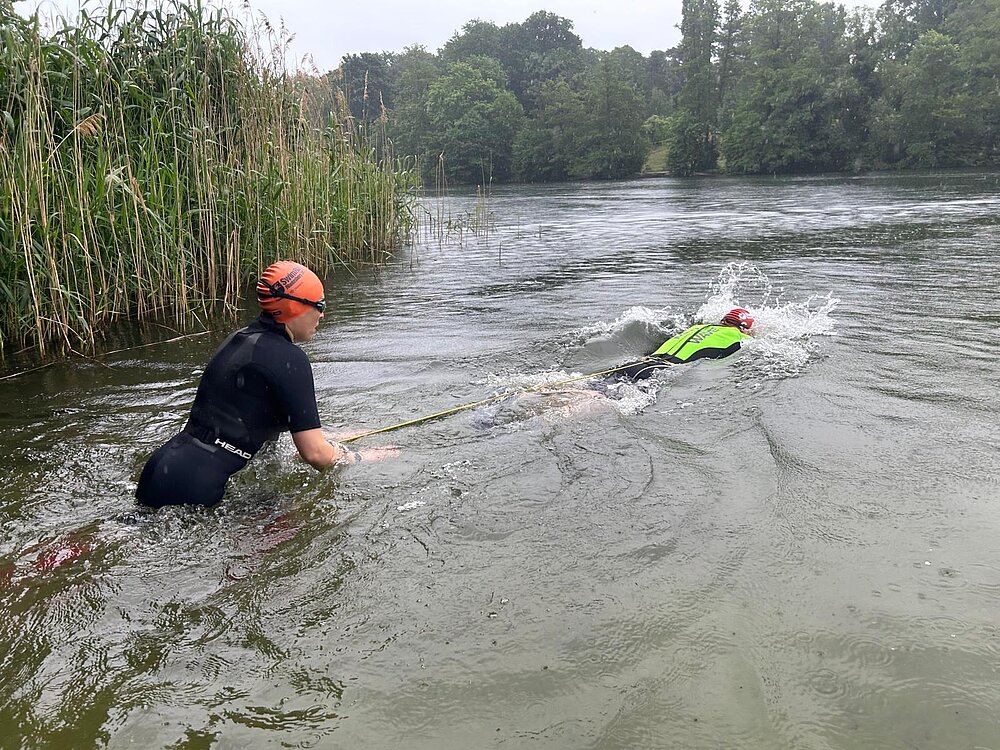
Finally into the water, additional rain from above didn't bother them. © SCC EVENTS / Philip Lehmann
7. Question to Celia: What do you do with your hair during SwimRun?
For SwimRun, I always use two hair ties to keep my hair secure. First, I make a bun with one tie, then I gather the loose strands and secure them with the second tie — creating a small, not-so-pretty but very practical mini-bun. The biggest challenge is not overheating and being able to take off and put on the swim cap without the hair falling out completely.
8. Question to Celia: What are your absolute favorite pieces of SwimRun gear?
Socks! During my first SwimRun, I ended up with bloody blisters from the laces — since then, well-fitting socks are a must for me. For shoes, I go with lightweight trail shoes that drain or let water pass through easily. As for the wetsuit, when the temperature allows, I prefer a sleeveless, short wetsuit — it saves energy and leaves me with more power for the paddles. You can find more information about SwimRun gear here.
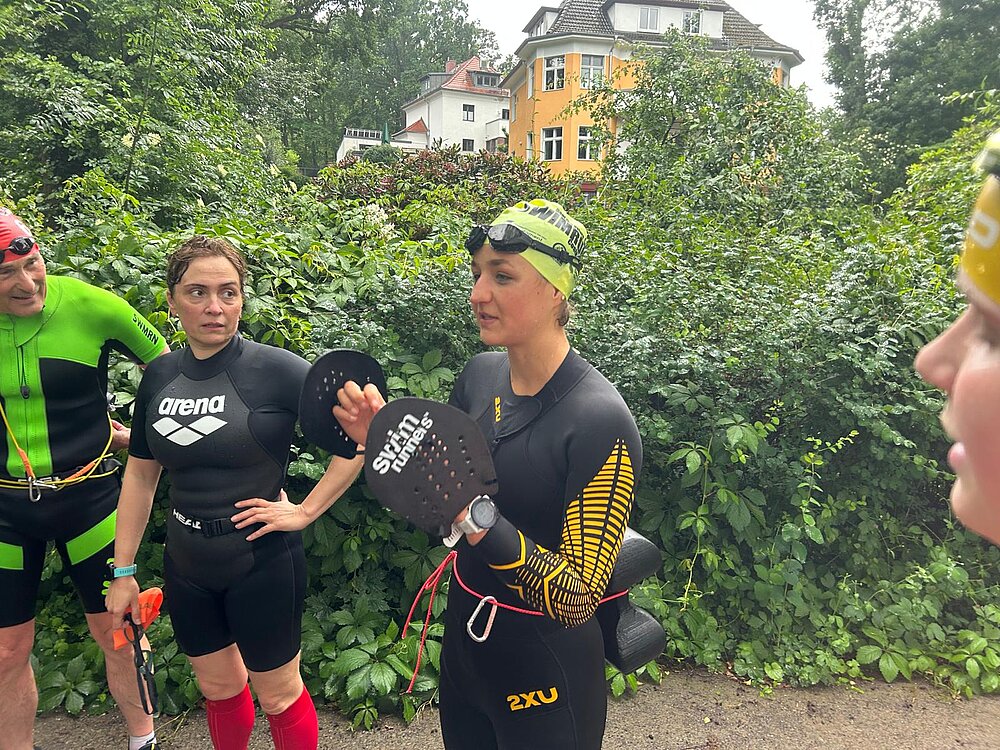
Throughout, Celia provided tips and tricks about SwimRun. © SCC EVENTS / Philip Lehmann
SCC EVENTS Training Courses and SwimRun Rheinsberg on Strava
By the way, this SwimRun training session is just one of many training opportunities offered by SCC EVENTS, the organizer of major sporting events like the BMW BERLIN-MARATHON. Click here to explore more training programs. And now you can also find SwimRun Rheinsberg on Strava — take a look!
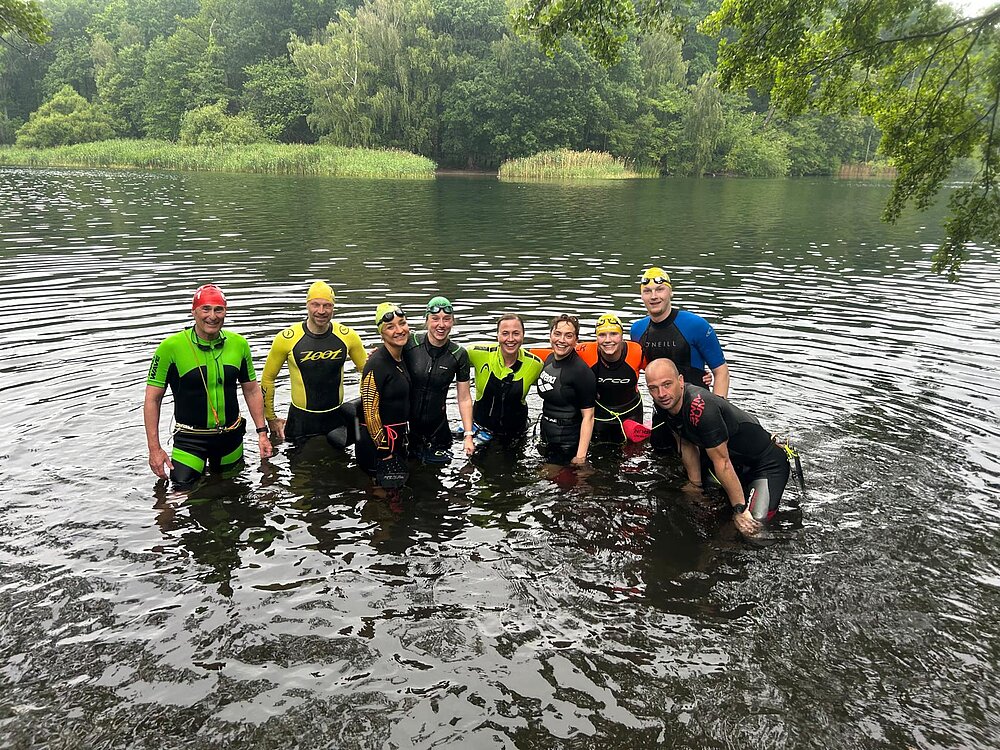
Done! After about 90 minutes, everyone was pretty tired but also very happy. © SCC EVENTS / Philip Lehmann



















